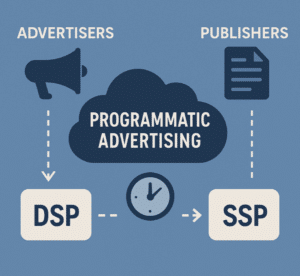Programmatic advertising is an automated ad buying system that uses advanced algorithms and AI to purchase digital ads across the internet. It allows advertisers to target in real time the most relevant audiences for what they sell and place ads in front of users at the right time, in the right place. Instead of manually negotiating ad placements, programmatic advertising uses algorithms to bid on available ad inventory across websites and apps; the process is completely automated. It’s rapid, precise, and laser-focused on the users who matter most to individual advertisers.
How Does Programmatic Advertising Work?
For sure, you’ve already been targeted through programmatic advertising. Whether you were searching for a new grill for that backyard barbeque or a sleek new pair of designer shoes, you left a trail. And the internet knows.
When you visit a website, data about your behavior, interests, browsing history (i.e., those searches), location, and device are collected. In milliseconds, an ad auction is triggered, and the data are sent to an ad exchange where advertisers bid to show an ad to you—for that grill or pair of shoes or anything else that fits your profile. Algorithms evaluate that unique profile to determine how much the ad impression is worth to an advertiser. Then the system selects the highest relevant bid. Faster than a camera flash—or the time it takes to load the page—an algorithm has already analyzed you and your actions, initiated an ad auction, received relevant bids, chosen a winner, and delivered an ad to your device. Voila! You see ads for grills and shoes everywhere you go online.
AI is at the core of programmatic advertising. Through machine learning, advertising campaigns are automatically and continuously optimized over time. Every impression, click, scroll, and conversion is tracked, creating a massive dataset about what works and what doesn’t. Millions of those data points are then analyzed to identify which combination of copy, creative, users, times, devices, and websites, lead to the best results. Machine learning looks for patterns in user behavior, ad engagement, and conversion trends over time. And based on the data, the algorithm adjusts bids, targeting, and placements to predict which users are most likely to take an action (like clicking or buying), so the system bids more aggressively for those impressions to prioritize high-performance. And as long as ad campaigns run, the system learns, optimizes, and improves, constantly testing, adapting, and reallocating budget where it’s likely to be most effective.
Programmatic Digital Advertising Is Fast
Before programmatic advertising, manual ad buying was a time-consuming, multi-step process that took days—or longer—to execute. Advertisers had to set up ad campaigns, select individual websites and publishers, negotiate rates and placements, submit insertion orders, execute contracts, and then build out copy and creative assets for approval. Publishers would then manually place ads onto their sites. And data was collected and reported over time. The entire process was labor-intensive and long.
Programmatic changed all that.
With programmatic, publishing effective and well-targeted ad campaigns takes milliseconds, without lots of back-and-forth and paperwork. Advertisers can participate in real-time bidding and win a top spot before a page is fully loaded. And since they’re likely bidding against dozens of other advertisers, speed is critical. The advertiser using the fastest way to feed you ads for shiny new grills is more apt to be the one that gets you to purchase theirs. And remember, you’re busy and your attention span is short. The internet knows this and so do advertisers. Using programmatic is fast, automated, effective, efficient, and scalable.
Can Anything Slow Down Programmatic Advertising?
So if speed is essential for programmatic advertising, can anything mess it up? Yes, from slow internet connections and overloaded servers to communication glitches between the demand-side platforms (advertisers) and the supply-side platforms (publishers), there are several factors that can slow even the lightning-fast programmatic methodology. Programmatic can also get tripped up if there’s poor or incomplete data or if targeting is so hyper-specific that the filtering limits available ad impressions. And just like with other internet advertising, new campaigns go through a “learning phase” where algorithms need to collect enough data to make accurate predictions.
Does Programmatic Advertising Rely On 3rd Party Cookies?
If you’ve been reading about the on-again-off-again concern of 3rd party cookies, you may be wondering where programmatic fits into the equation. Like most digital advertising systems, programmatic relies heavily on 3rd party cookies. Third-party cookies have long been used to track users across websites, build audience segments, retarget, and measure ad performance. And while browsers like Safari and Firefox have already deprecated 3rd party cookies, Google keeps moving its self-imposed deadlines. Plans for a 2025 end to 3rd party cookies for Chrome were recently shelved.
Even if 3rd party cookies go back on the chopping block, it’s likely that programmatic advertising will find a way to adapt. The systems will need to rely more on 1st party data, using AI for cohort-based and contextual targeting and finding privacy-friendly ways to connect with consumers.
Are you ready to leverage the power of programmatic advertising for your organization? The experts at CloudControlMedia combine programmatic advertising built on artificial intelligence with human intelligence to get the most out of the systems. Our digital savvy, years of experience, and data-driven mindset assure that automatic campaigns are never set to autopilot. If you want to find, engage, and convert more users at scale, we’ve got you covered. Contact us today to find out how you can best reap the rewards of programmatic display advertising.


